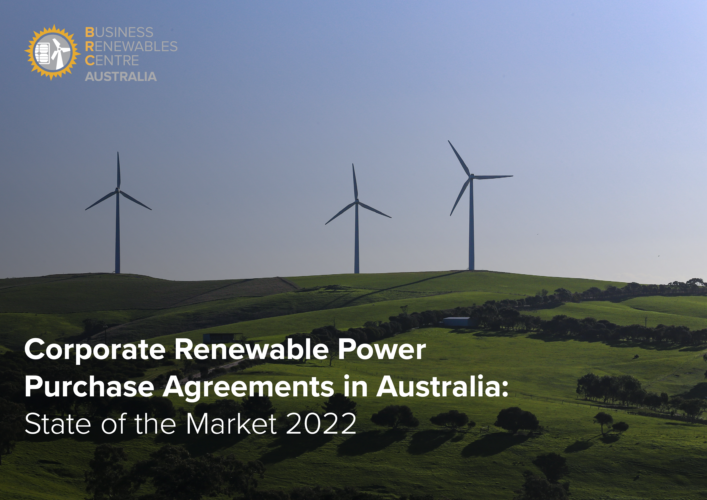3 March 2023, Sydney – The Business Renewables Centre Australia (BRC-A) released their fourth Annual State of the Market Report today. The State of the Market 2022 report provides an overview of the Corporate Renewable Power Purchase Agreements (Corporate PPAs) sector and its key trends. The purpose of the report is to provide an overview of PPA market trends. The original data in the report is drawn from two primary sources:
- The BRC-A maintains a database of Corporate PPAs based on publicly available information and supplemented through industry contacts.
- An annual survey of corporate buyers, project developers and professional Service Providers in the industry and BRC-A membership.
Summary of Findings
The emergence and growth of Corporate PPAs has been one of the major changes to the market for large-scale renewable energy. Since 2017, based on public information the BRC-A estimate there have been 137 Corporate PPAs negotiated, contracting over 5.6 GW of renewable energy generation.
The growth in Corporate PPAs has diversified the market for large-scale renewable energy and they are now playing an important role in energy transition. As retailer PPAs slowed once their legislated purchase obligations under the Renewable Energy Target, Corporate PPAs and public sector retailers have been the source of ongoing investment in large-scale.
Amidst the extraordinary market volatility and record wholesale electricity prices, the State of the Market report highlights both change and continuity in the Corporate PPA sector:
- Corporate PPA deal volumes in 2022 were the highest recorded: In 2022, around 1.6 GW of capacity were signed through Corporate PPAs. For three years running, Corporate PPAs have been over or just under 1 GW and the major market segment ahead of public sector retailers, utility PPAs or merchant projects.
- Market volatility had mixed impacts on demand for Corporate PPAs: The National Electricity Market experienced unprecedented wholesale electricity price increases and volatility during 2022. BRC-A’s industry survey found divergent views on whether the price volatility had a positive or negative impact on demand for Corporate PPAs, which matches anecdotal feedback. For some organisations, crisis management and uncertainty stalled plans for a PPA. Amongst other organisations, the market volatility stimulated a rush to sign a PPA. In the medium term, memories of the price spike are likely to support growth in Corporate PPAs to reduce exposure to electricity price movements.
- The PPA market continues to be driven by buyers with sustainability targets: Notwithstanding the market volatility, for the third year running the major driver for PPA buyers were renewable energy or emissions targets, corporate social responsibility policies or reputation. The growth in organisations with net zero targets by 2025 or 2030 is likely to solidify this trend. In the midst of market volatility, there is an alignment of financial and sustainability drivers that is likely to underpin ongoing strength in the Corporate PPA market.
- Corporate PPAs with new projects collapsed in 2022 reflecting wider industry trends – but the PPA market appears to be broadly in good health: Until the last quarter of 2022, there were virtually no Corporate PPAs with new projects last year. The growth of PPAs with operating projects has been occurring for several years as retailers supply demand from smaller buyers. However, the decline in PPAs with new projects in 2022 appears to primarily reflect wider constraints that have impacted on project supply, such as grid connections. PPA prices increased this year – albeit not as much as electricity prices – reflecting a combination of supply-side factors (such as supply-chain inflation and rising interest rates) and demand outstripping supply. The Corporate PPA market became a ‘sellers market’ as buyers chased a diminishing pool of projects.
The decline of PPAs with new projects naturally sparks debate about the additionality and impact of Corporate PPAs. A healthy Corporate PPA market should exhibit a mix of buyer sizes across sectors and PPA models to reflect market segments, stretching from PPAs with larger buyers underwriting new projects, and retailers on-selling PPAs from operating projects to medium-sized buyers. Notwithstanding the decline in Corporate PPAs with new projects, there remains a healthy diversity across buyer sizes and sectors within the Corporate PPA sector. If the wave of major government policy and program initiatives works to stimulate project supply the volume of Corporate PPAs with new projects is also likely to pick up.
- The return of wholesale PPAs: whilst there had been a marked shift from Wholesale PPAs (contracts-for-difference or derivatives directly with projects) to Retail PPAs (PPAs intermediated by retailers between the project and buyers) in the last couple of years, Wholesale PPAs staged a return this year. Notably, the increase in future electricity prices has increased the cost of firming, and therefore improved the relative value of Wholesale PPAs.
The BRC-A’s annual survey collects information on the key barriers to Corporate PPAs and processes. Here, there was strong continuity with surveys from the past three years. The major findings were:
- PPAs remain a challenging undertaking with most buyers rating the difficulty high or very high – though transaction costs are generally rated lower.
- The major barriers to PPA execution are internal to buyer organisations: buyer understanding, complexity and building organisational support for PPAs are the key challenges – though more buyers identified market uncertainty as a barrier this year.
- PPAs take time: the most common deal length was 12-18 months and over half of buyers estimated it longer than 18 months.
- Financial risk, price and developer reputation are the most important factors for buyers: for three years these have been the most important factors nominated by buyers when assessing PPAs.
- Community support and benefits, local jobs and environment and biodiversity are less important – but more significant to buyers than developers recognise. Whilst they are not rated as important as the top-line considerations, social and environmental considerations are more important than most developers recognise. Around half of buyers rate social and environmental considerations as very important or important.
Whilst 2022 was an incredibly challenging year in the National Electricity Market, Corporate PPAs have continued to be an effective vehicle for renewable energy procurement – and are likely to continue to play a significant role in Australia’s energy transition.
Every year, the Business Renewables Centre Australia releases a State of the Corporate PPA Market Report to shed light on trends in renewable energy offtake behaviour across Australia’s National Electricity Market (the NEM). The report uses anonymised and aggregated data from its annual survey which invites supply-side and demand-side players to respond on matters relating to PPAs. In addition to survey data, BRC-A keeps a database of all publicly announced PPAs which forms the basis of the trends observed in the report.
About the survey
Under the terms of the funding agreement with ARENA and ethics policy within the University of Technology, we are required to maintain the confidentiality of data. All individual responses are strictly anonymous and aggregated. If it is possible for an individual organisation to be identified because of a small sample size, the data will not be made public.
If you have any concerns or questions about the research contact Dr Chris Briggs, Technical Director at BRC-A and Research Director at UTS Institute for Sustainable Futures at chris.briggs@uts.edu.au.





